Common House Spider
Parasteatoda tepidariorum
House spiders have the ability to eat most insects in a home.
Advertisement
Common House Spider Scientific Classification
- Kingdom
- Animalia
- Phylum
- Arthropoda
- Class
- Arachnida
- Order
- aranae
- Family
- Theridiidae
- Genus
- Parasteatoda
- Scientific Name
- Parasteatoda tepidariorum
Read our Complete Guide to Classification of Animals.
Common House Spider Conservation Status
Common House Spider Locations

Common House Spider Facts
- Prey
- Mosquitoes, flies, ants
- Name Of Young
- Spiderling
- Group Behavior
- Solitary
- Fun Fact
- House spiders have the ability to eat most insects in a home.
- Biggest Threat
- Loss of habitat, pesticides
- Most Distinctive Feature
- Eight spindly legs
- Other Name(s)
- House spider
- Gestation Period
- 30-50 days
- Litter Size
- 400+ eggs
- Habitat
- The corners of a room
- Predators
- Birds, cats, dogs, wasps
- Diet
- Carnivore
- Type
- Insect
- Common Name
- House spider
- Location
- Worldwide
- Group
- Solitary
View all of the Common House Spider images!
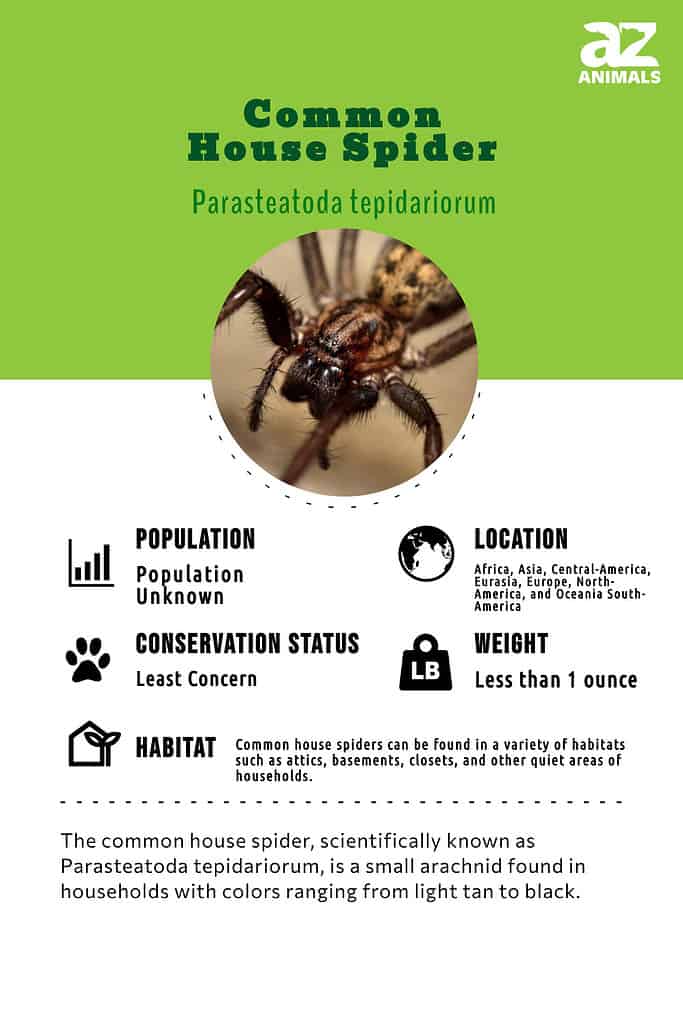
A single common house spider egg sac may contain 400 eggs or more
Common house spiders make their webs in the corners and nooks of a home. They are very small creatures measuring less than one-quarter of an inch in length. They live on a diet of flies, mosquitoes, fleas, and ants. Though these spiders have venom, their bite is considered harmless to people and pets.
4 Incredible Common House Spider Facts!
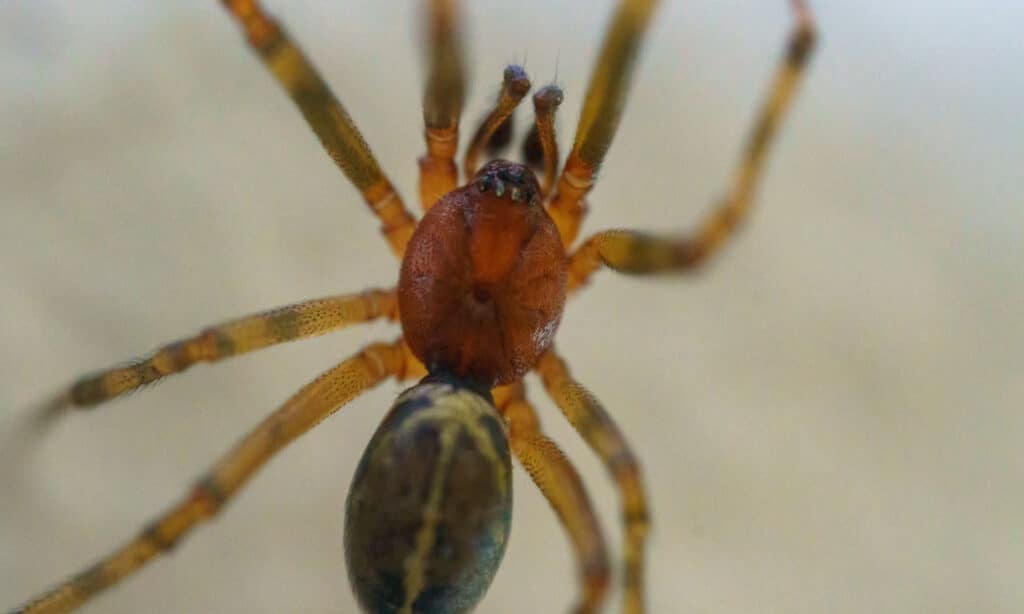
A few of these spiders have a dietary habit of consuming food four times daily.
©M-Production/Shutterstock.com
- Some of these spiders eat four times each day
- If it’s not capturing enough insects, this spider will move to another location
- Though they are solitary, these spiders sometimes build webs near each other
- Their dark colors help to camouflage them in a home
Here are some other common spiders found in homes:
- Wolf spiders
- Brown recluse spider
- Cellar spiders
- Jumping spiders
- Orb-weaver spiders
- Widow spiders
- Hobo spider
- Black house spider
- Grass spiders
- Tegenaria domestica
- Yellow Sac Spider
- Giant house spider
- Sac spiders
- Zebra Jumping Spider
- Pholcus phalangioides
- Southern house spider
- Furrow spider
- Tan jumping spider
- Black-footed yellow sac spider
- Brown widow
- Araneus gemmoides
- Agelenidae
- Red-backed jumping spider
- Cardinal spider
Species, Types, and Scientific Names
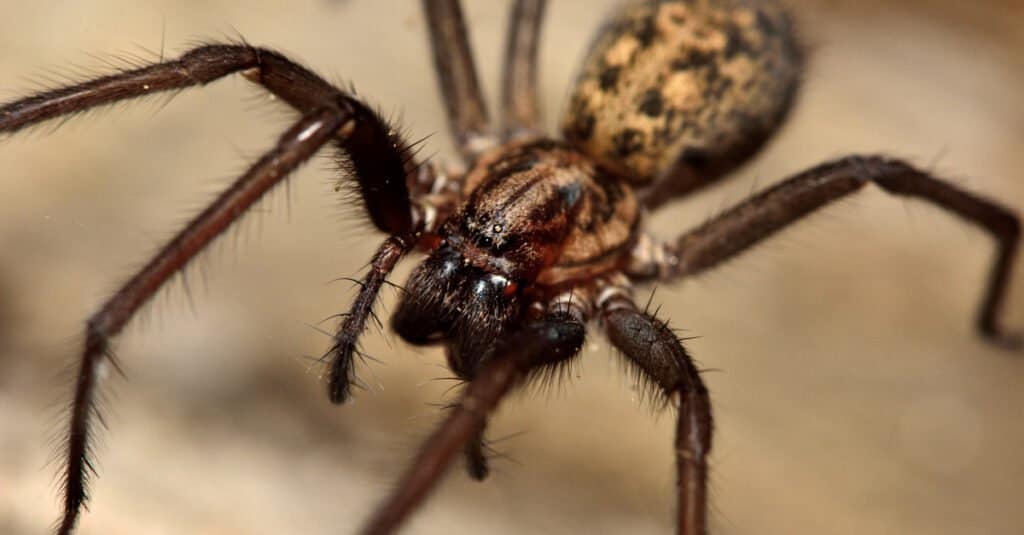
The common household spider, which is occasionally referred to as the American house spider, is scientifically known as Parasteatoda tepidariorum.
©IanRedding/Shutterstock.com
Parasteatoda tepidariorum is the scientific name of the common house spider, which is also sometimes called the American house spider. The word Parasteatoda refers to the genus of the spider and the Latin word tepidariorum relates to a warm environment. These spiders take shelter inside warm homes or other structures.
They belong to the Theridiidae family and the order Araneae. There is one subspecies of the common house spider known as the common gray house spider.
There are 10 other types of spiders that fall into the general category of house spiders. These include:
- Black house spider- Badumna Insignis
- Brown house spider- Steatoda grossa
- Common cellar spider- Pholcus phalangioides
- Domestic house spider- Tegenaria domestica
- Giant house spider- Eratigena atrica
- Hobo spider- Eratigena agrestis
- Geometric house spider- Latrodectus Geometricus
- Tiny house spider- Oonops domesticush
- Yellow sac spider– Chiracanthium inclusum
- Southern house spider- Kukulcania hibernalis
Evolution and Origins
Similar to all present-day arthropods, the spiders that inhabit your attic may have originated from marine creatures that were up to 7 feet long and existed 480 million years ago.
While true spiders evolved around 300 million years ago, they predate not only humans but also dinosaurs.
It is believed that spiders originated approximately 400 million years ago from ancestors that were arachnids with thick waists, and had recently transitioned from aquatic environments.
The earliest spiders that can be identified with certainty are arachnids with slender waists, abdominal segmentation, and spinnerets used for producing silk, such as the Attercopus fimbriungus fossils.
Appearance: How to Identify
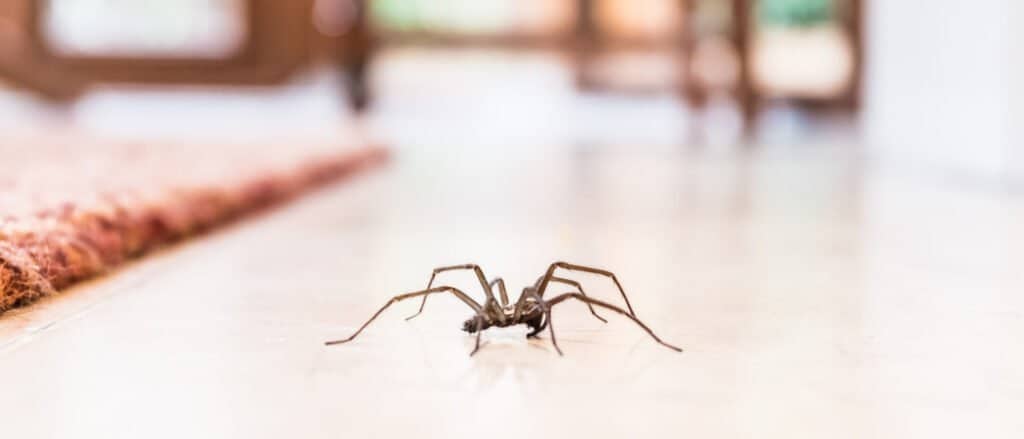
A variety of colors can be observed in the common household spider, spanning from pale beige to deep black.
©Christine Bird/Shutterstock.com
The common house spider is found in colors ranging from light tan to black. Females are 0.19 to 0.24 inches in length. Males are smaller in size measuring 0.15 to 0.19 inches long. These spiders weigh less than one ounce.
One of the features setting male common house spiders apart from females is the orangish-brown coloration on their legs.
These spiders have eight spindly legs and eight eyes. Surprisingly, even with so many eyes, they can’t see more than three or four inches in front of them.
One of the most interesting things about the common house spider is its body is similar in shape to the black widow spider. They both have bulb-shaped abdomen. But, despite a similar shape, the venom of a black widow spider is far more dangerous.
The Giant house spider is the largest type of house spider. The body of a female giant house spider can grow to almost three-quarters of an inch. Furthermore, they have a leg span of 1.8 inches.
Their dark colors help common house spiders disappear into the corner of an attic, garage, basement, or spare room in a home. In addition, their coloration can keep them hidden from cats, birds, and dogs that could consume them in one gulp. Though their venom kills small insects, it’s not powerful enough to harm a larger animal.
Common house spiders are mostly solitary with one exception. Scientists have observed males and females occupying the same web while they go through the mating process.
It’s not unusual to find the webs of two or three common house spiders in the same general space without being right next to one another. This is probably because there is an ample food source in the area.
Habitat
Common house spiders populate every area in the world except for Antarctica. True to their name they live in corners of homes, attics, garages, and garden sheds. When looking for a place to build a web, these spiders choose an area where the air is flowing. A corner of a window where the air is leaking in from outside is a common place to find this spider.
A corner in a drafty room or near a pipe that is coming in through an exterior house wall is both favorable places to find this spider’s web. The flow of air increases the chances that a fly, mosquito, flea, or other insect will move through the area.
Diet

Being carnivorous, spiders consume other organisms as their source of nutrition. They are active at night, and during this time, they feed and undertake repairs to their webs.
©Dan Olsen/Shutterstock.com
Spiders are carnivores. They are nocturnal so they eat and make repairs to the web at night.
What eats common house spiders?
Common house spiders are eaten by birds, spider wasps, centipedes, and sometimes domesticated dogs and cats.
What does a common house spider eat?
A common house spider captures flies, mosquitoes, ants, fleas, and other small insects in the sticky strands of its web. When an insect is caught, the spider puts additional silk threads on top of it. This spider bites its prey and injects it with venom to liquefy its organs. It drinks the insides of its prey and consumes any parts that are not too hard to ingest.
If you observe a common house spider in your home, look at the area beneath its web. The tiny pieces of debris are the discarded parts of its prey.
Prevention
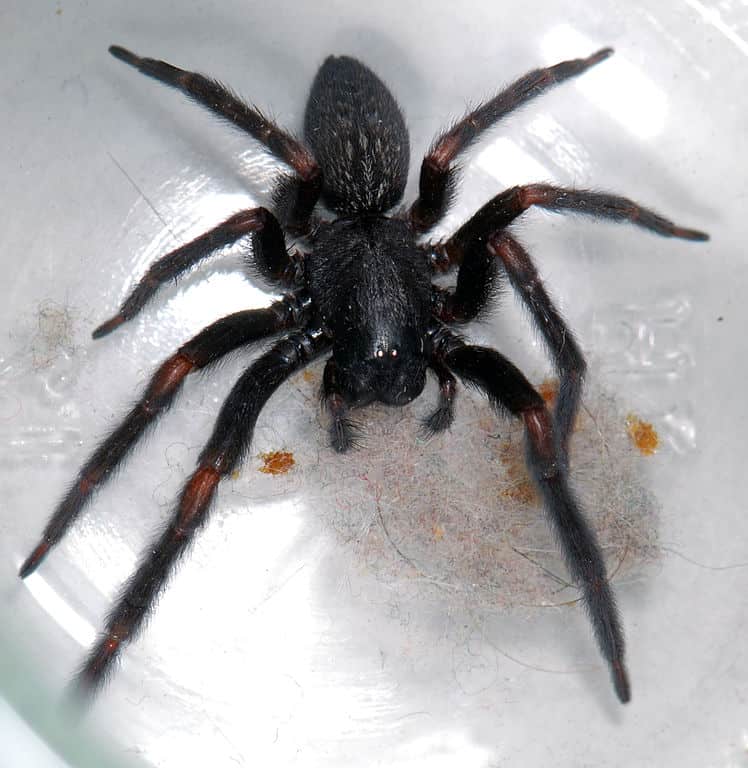
A single common household spider has the ability to eliminate a substantial number of insects within a household.
©Peter Halasz (User:Pengo) / CC BY-SA 2.5 – License
One common house spider can get rid of a lot of insects in a home. Getting rid of these spiders can mean an increase in pesky flies, mosquitoes, and ants in a home.
However, some homeowners object to the webs and the debris beneath the webs left behind by these spiders. There are ways to get rid of common house spiders or discourage them from making webs in your home.
One way to discourage these spiders from entering your home is to make it less appealing. Check the insulation around your windows and doors.
When you vacuum your carpet, be sure to clean the baseboards too. Use your vacuum cleaner’s extension wand to clean all the corners of the room.
A natural repellent is another option. Spray it in various corners to discourage common house spiders from constructing their webs and laying eggs.
View all 235 animals that start with CCommon House Spider FAQs (Frequently Asked Questions)
How many legs does a common spider have?
Common house spiders have eight legs. This is one of those features along with enjoying a diet of insects shared by many types of spiders.
How do you identify a common house spider?
The colors of common house spiders range from tan to black. Males have a combination of orange and brown on their legs. The size of this spider’s body is less than one-quarter of an inch long.
If you see a large common house spider, it’s probably a female because they are bigger than males.
A female’s eggs are contained in a sac that looks like it’s made of very thin, brown paper. This is a common sight in this spider’s web.
One of the most notable features of this spider is its messy web. Other types of spiders spend hours building intricate webs complete with spirals and radials. But, a common house spider builds a web of uneven silken threads attached to a wall and whatever objects are around it. But, despite being a little messy, it serves its purpose!
Are common house spiders dangerous?
No, they are harmless. These spiders do have venom that they use on their regular diet of small insects. But this venom is not powerful enough to harm a human or even a pet.
What is the most common house spider to find in your house?
The American house spider is most often found in houses.
What does a common house spider bite look like?
The bite of this spider looks a lot like a small blister with a ring of red around it. Though it’s harmless to a human, it may itch a little bit as it heals.
Thank you for reading! Have some feedback for us? Contact the AZ Animals editorial team.
Sources
- University of Wyoming, Available here: http://www.uwyo.edu/cesinsects/spider/eight-legged%20facts.htm
- Wikipedia, Available here: https://en.wikipedia.org/wiki/Giant_house_spider
- Treehugger, Available here: https://www.treehugger.com/facts-about-misunderstood-house-spider-4868827
- ZME Science, Available here: https://www.zmescience.com/other/did-you-know/common-spiders-living-house/
- Galveston County Master Gardeners, Available here: https://aggie-horticulture.tamu.edu/galveston/beneficials/beneficial-22_spiders-overview.htm
















